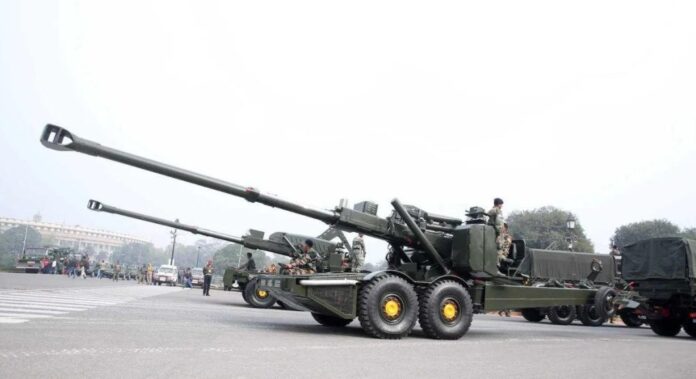

India, on 16 March, cleared the decks for buying indigenous military hardware worth ₹70,500 crore ($8.5 billion), including supersonic missiles, artillery guns, maritime helicopters and a long-range standoff weapon.
The decision by the defence acquisition council (DAC), India’s top weapons procurement body, builds on the push for self-reliance in the defence manufacturing sector.
The council accorded its acceptance of necessity (AoN) for 225 BrahMos missiles, Shakti electronic warfare systems and 60 utility helicopters for the navy, around 300 advanced towed artillery gun systems (ATAGS) for the army, the long-range stand-off weapon for the Indian Air Force’s Sukhoi-30 fighters, and nine advanced light helicopters for the coast guard.
Under India’s defence procurement rules, the council’s AoN is the first step towards buying military hardware. The DAC’s clearance for the military hardware is under the most important category of acquisition for indigenisation under the defence procurement policy, or the Indian-IDDM category. IDDM stands for indigenously designed, developed and manufactured.
The government will spend the lion’s share of the money on boosting the navy’s capabilities. The BrahMos missiles, Shakti EW systems and utility helicopters for the navy are estimated to cost ₹56,000 crore, the defence ministry said.
“While the additional BrahMos missile systems will enhance the maritime strike capabilities and anti-surface warfare operations, the utility helicopters will multiply the operational readiness of the Indian Navy for search and rescue operations, casualty evacuation, and humanitarian assistance disaster relief. The EW systems will equip and modernise frontline warships to counter any action by the adversaries,” it said in a statement.
The 155mm/52-caliber ATAGS will be bought for the army along with high mobility and gun-towing vehicles, the ministry said. The Defence Research and Development Organisation (DRDO) began the ATAGS project in 2013 to replace older guns with modern ones. It partnered with two private firms, Bharat Forge Limited and Tata Advanced Systems Limited, for manufacturing the gun. It has a range of 48 km.
A prototype of the gun was used for the ceremonial 21-gun salute for the first time at the Independence Day function at Red Fort last year, along with British guns traditionally used for the event. In his speech, Prime Minister Narendra Modi made a special mention of the indigenous artillery gun as he called for furthering self-reliance in different sectors.
The DAC also cleared the development and production of medium speed marine diesel engines under the ‘Make-I category’ for the first time. “India is venturing into the development and manufacturing of such engines indigenously to achieve self-reliance and leverage the capabilities of the industry towards the goal of Aatmanirbhar Bharat,” the ministry said.
‘Make-I’ is category of capital acquisition in the Defence Procurement Procedure (DPP), and the cornerstone of the Make in India initiative that seeks to build indigenous capabilities through the involvement of both public and private sector.
‘Make-I’ refers to government-funded projects while ‘Make-II’ covers industry-funded programmes. Another sub-category under ‘Make’ is ‘Make-III’ that covers military hardware that may not be designed and developed indigenously, but can be manufactured in the country for import substitution, and Indian firms may manufacture such hardware in collaboration with foreign partners.
The DAC has so far granted AoN for capital acquisition in 2022-23 for projects worth over ₹2.71 lakh crore ($32.77 bn), of which 99% procurement will be done from the domestic industry, it added.
The latest DAC clearance comes on the back of the defence ministry signing on March 7 two separate contracts with Hindustan Aeronautics Limited (HAL) and Larsen & Toubro for 70 HTT-40 basic trainer aircraft and three cadet training ships, respectively, with the orders worth ₹9,900 crore set to boost self-reliance.
Apart from creating a separate budget for buying locally made military hardware, the government has taken a raft of steps to promote self-reliance in the defence manufacturing sector including increasing foreign direct investment (FDI) from 49% to 74%, and notifying hundreds of weapons and systems that cannot be imported.
At Aero India 2023, the defence minister announced that India had earmarked 75% of this year’s defence capital procurement budget for buying weapons and systems from local manufacturers, with the move aimed at unlocking new opportunities for achieving self-reliance targets and ramping up the country’s defence exports.
The share of the domestic sector in the defence budget was never higher. India set aside 68% of the military’s capital acquisition budget for making indigenous purchases in 2022-23, 64% in 2021-22, and 58% in 2020-21.
Around ₹1 lakh crore has been set aside for domestic procurement this year, compared to ₹84,598 crore, ₹70,221 crore and ₹51,000 crore in the three previous years.
Singh had earlier indicated that India could bring more weapons and systems under an import ban, and manufacture them in the country to give a new push to self-reliance. So far, four ‘positive indigenisation lists’ have barred the import of 411 weapons and systems.
















